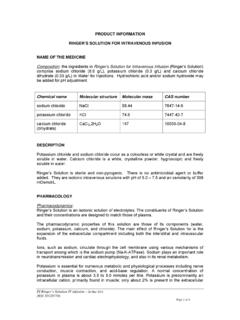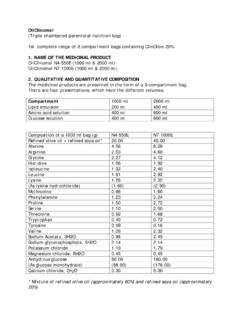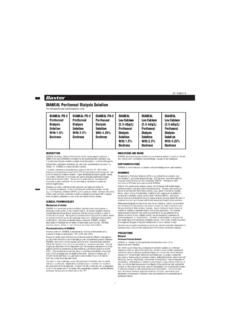Transcription of OSMITROL INTRAVENOUS INFUSION (MANNITOL …
1 OSMITROL INTRAVENOUS INFUSION (Mannitol) Product Information Page 1 of 12 OSMITROL INTRAVENOUS INFUSION (MANNITOL INTRAVENOUS INFUSION , BP) Name of the Medicine Osmitro l INTRAVENOUS INFUSION (Mannitol INTRAVENOUS INFUSION , BP) contains Mannitol. It contains no antimicrobial agents. Description Osmitro l INTRAVENOUS INFUSION (Mannitol INTRAVENOUS INFUSION , BP) is a sterile, nonpyrogenic solution of Mannitol BP, in a single dose container for INTRAVENOUS administration. Mannitol C6H14O6 is a six carbon sugar alcohol prepared commercially by the reduction of glucose. The molecular weight for Mannitol is , CAS Number 69-65-8. Although virtually inert metabolically in humans, it occurs naturally in fruits and vegetables.
2 Mannitol is an obligatory osmotic diuretic. The pH is adjusted with sodium hydroxide and hydrochloric acid. Composit ion, osmo larit y and pH are shown in Table 1. Table 1 Size Composition (Mannito l BP) *Osmolality mOsmol/kg pH 10% OSMITROL IV INFUSION (10% Mannitol IV INFUSION BP) 1000 mL 100 g/1000mL 596 ( to ) 20% OSMITROL IV INFUSION (20% Mannitol IV INFUSION BP) 500 mL 100g/500mL 1192 ( to ) *An injection with an osmolality within the range of 250 to 350 mOsm/kg is considered to be isotonic. Administration of substantially hypertonic solutions may cause vein damage. The VIAFLEX plastic container is fabricated from a specially formulated polyvinyl chloride (PL 146 Plastic). The amount of water that can permeate from inside the container into the overwrap is insufficient to affect the solution significantly.
3 Solutions in contact with the plastic container can leach out certain of its chemical components in very small amounts within the expiration period, di-2- ethylhexyl phthalate (DEHP), up to 5 parts per million. However, the safety of the plastic has been confirmed in tests in animals according to USP biological tests for plastic containers as well as tissue culture toxicity studies. OSMITROL INTRAVENOUS INFUSION (Mannitol) Product Information Page 2 of 12 Pharmacology Osmitro l INTRAVENOUS INFUSION (Mannitol INTRAVENOUS INFUSION BP) is one of the non-electrolyte, obligatory, osmotic diuretics. It is freely filterable at the renal glomerulus, is poorly reabsorbed by the renal tubule, is not secreted by the tubule, and is pharmacologically inert.
4 Mannitol, when administered intravenously, exerts its osmotic effect as a solute of relatively small molecular size being largely confined to the extracellular space. Only relatively small amounts of the dose administered are metabolised. Mannitol is readily diffused through the glomerulus of the kidney over a wide range of normal and impaired kidney function. In this fashion, approximately 80% of a 100 gram dose of Mannitol will appear in the urine in three hours with lesser amounts thereafter. Even at peak concentrations, Mannitol will exhibit less than 10% of tubular reabsorption and is not secreted by the tubular cells. Mannitol will hinder tubular reabsorption of water and enhance excretion of sodium and chloride by elevating the osmo larity of the glomerular filtrate.
5 The increase in extracellular osmolarity affected by the INTRAVENOUS administration of Mannitol will induce the movement of intracellular water to the extracellular and vascular spaces. The action underlies the role of Mannitol in reducing intracranial pressure, intracranial oedema, and reducing elevated intraocular pressure. Indications Osmitro l INTRAVENOUS INFUSION (Mannitol INTRAVENOUS INFUSION , BP), can be used in: The promotion of diuresis, in the prevention and/or treatment of the oliguric phase of acute renal failure before irreversible renal failure becomes established; The reduction of elevated intraocular pressure when the pressure cannot be lowered by other means; The reduction of intracranial pressure and treatment of cerebral oedema by reducing brain mass and.
6 Promoting the urinary excretion of toxic substances Contraindications Osmitro l INTRAVENOUS INFUSION (Mannitol BP) is contraindicated in patients with: Hypersensit ivit y to Mannitol Pre-existing plasma hyperosmo larit y Severe heart failure Disturbance of the blood-brain barrier Well established anuria due to severe renal disease No response to test dose Severe pulmonary congestion or frank pulmonary oedema OSMITROL INTRAVENOUS INFUSION (Mannitol) Product Information Page 3 of 12 Active intracranial bleeding except during craniotomy Severe dehydration Progressive renal damage or dysfunction after institution of Mannitol therapy, including increasing oliguria and azotemia, and Progressive heart failure or pulmonary congestion after institution of Mannitol therapy.
7 Precautions General OSMITROL is hypertonic. Hypertonic solutions should be administered via a large peripheral and preferably central vein. Rapid INFUSION in peripheral veins may be harmful Hypersensitivity Anaphylactic/anaphylactoid reactions, including anaphylaxis, as well as other hypersensitivity/ INFUSION reactions have been reported with mannitol. Fatal outcome has been reported. (See Adverse Reactions section) The INFUSION must be stopped immediately if any signs or symptoms of a suspected hypersensitivity reaction develop. Appropriate therapeutic countermeasures must be instituted as clinically indicated. Risk of renal complications Reversible, acute oligoanuric renal failure has occurred in patients with normal pre-treatment renal funct ion who received large INTRAVENOUS doses of mannitol.
8 In patients with severe impairment of renal function, a test dose should be utilised (see dosage and administration). A second test dose may be tried if there is inadequate response, but no more than two test doses should be attempted. Patients with pre-existing renal disease, or those receiving potentially nephrotoxic drugs, are at increased risk of renal failure following administration of OSMITROL . Serum osmolarity, urine flow and renal function should be mo nitored particularly clo sely. The acid base, renal function and serum osmolarity must be monitored carefully when OSMITROL is used. Should patient serum osmolarity increase during treatment, the effects of OSMITROL on diuresis and reduction of intracranial and intraocular pressures may be impaired.
9 Osmotic nephrosis, a reversible vacuolisation of the tubules of unknown clinical significance, may proceed to severe irreversible nephrosis, so that the renal function must be closely monitored during Mannitol INFUSION If urine output continues to decline during Mannitol INFUSION , the patient s clinical status should be closely reviewed and Mannitol INFUSION suspended if necessary. Accumulation of Mannitol may result in overexpansion of the extracellular fluid, which may intensify existing or latent congestive heart failure. OSMITROL INTRAVENOUS INFUSION (Mannitol) Product Information Page 4 of 12 CNS toxicity CNS toxicity manifested by, confusion, lethargy and coma has been reported in patients treated with mannitol, in particular in the presence of impaired renal function.
10 Fatal outcomes have been reported. CNS toxicit y may result from: High serum mannito l concentrations Serum hyperosmolarity resulting in intracellular dehydration within the CNS Hyponatraemia or other disturbances of electrolyte and acid/base balance Secondary to mannito l administration. At high concentrations, mannitol may cross the blood brain barrier and interfere with the abilit y of the brain to maintain the pH of the cerebrospinal fluid especially in the presence of acidosis. A rebound increase in intracranial pressure may occur approximately 12 hours after the use of Mannitol for the reduction of intracranial pressure. The use of Mannitol in acute traumatic brain injury and acute stroke is not recommended. This is based on 2 Systematic Reviews that indicate the potential for harm and lack of sufficient data for a definitive assessment of the risk or benefit for using Mannitol in these two clinical conditions.
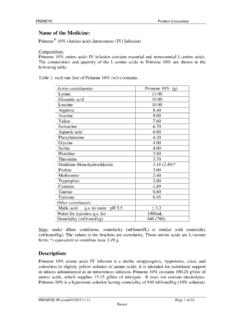
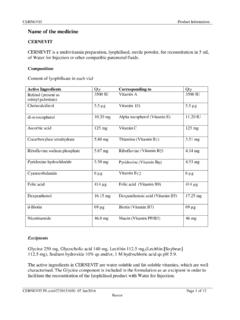
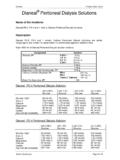
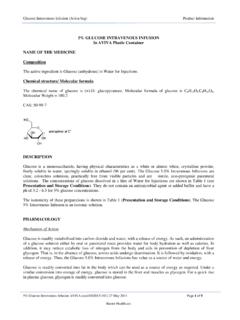
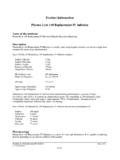
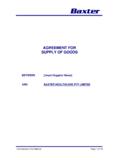
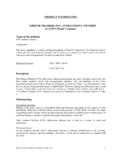
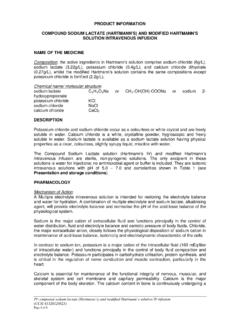
![T I S S E E L [Fibrin Sealant] - Baxter Healthcare](/cache/preview/5/e/c/8/3/b/b/2/thumb-5ec83bb2d349410260af6c556ae67fe3.jpg)
